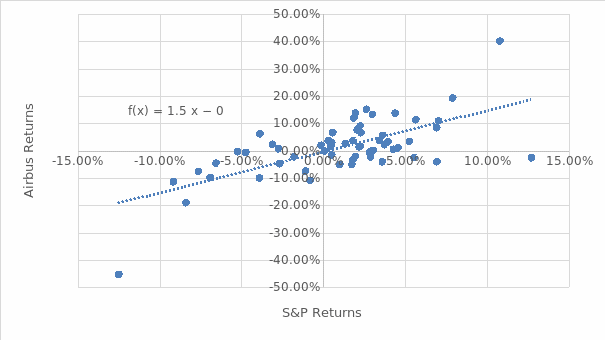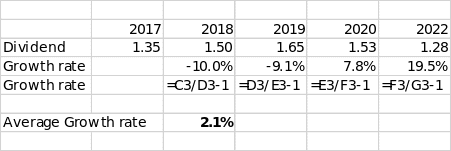Introduction
Airbus Company Overview
Airbus is one of the world’s leading aerospace companies. It designs, manufactures, and sells commercial aircraft, helicopters, and satellites. Airbus is also a major provider of aeronautical services, has a robust global presence, and is committed to innovation. The company was founded in 1970 and is headquartered in Toulouse, France (Airbus, n.d.).
Airbus is chosen for this analysis because it is a large and well-established company in the aerospace industry with a long history of profitability and a solid financial position. In addition, Airbus is a publicly-traded company, institutional investors widely hold its stock, and its WACC can provide insights into how the company competes with its rivals.
Computation of Cost of Capital for Airbus Company
Risk-Free Rate (rf)
The risk-free rate used in this analysis is the 10-year US Treasury yield as of December 31, 2021, which was 1.52% (U.S. Department of Treasury, 2021). The 10-year US Treasury yield is a good proxy for the risk-free rate because it is closer to the maturity of most bonds and is one of the most liquid and closely-watched government bond markets in the world.
Equity Market Risk Premium (ERP)
The equity risk premium can be calculated using the following formula: Equity market risk premium (ERP) = expected return on the market (Rm) – risk-free rate (rf). Equity Risk Premium for the U.S was estimated at 4.24%, as per the recommendation of Damodaran (2022). Therefore, using the U.S expected return of 5.76% as the expected return on the market for the overall market, the equity risk premium for Airbus would be; ERP = 5.76% – 1.52% = 4.24%.
Beta (Bi)
To arrive at Beta, Airbus’s last five years’ monthly returns are plotted against the S&P 500, and the linear regression line that best fits the data is computed as shown in graph one below.

The slope of the linear regression line, which represents beta, is 1.5038. This means that Airbus stock has been, on average, 50% more volatile than the market as a whole.
Cost of Common Equity (Ke) Calculation
Using the Capital Asset Pricing Method (CAPM)
The cost of equity under the CAPM method is calculated using the following formula; Expected return = Risk-Free Rate + [Beta x Market Return Premium]. With the previously explained inputs, the Cost of Equity is computed as follows: Ke = 1.52% + 1.50 ∗ 4.24% = 9.67%.
Using the dividend discount model
Cost of equity = Dividend per share (D1) / Share price (Po) + Dividend growth rate (g). Dividends made by Airbus from their annual profits to their shareholders are shown below; similarly, the current dividend share price for Airbus is 109.36 USD (Airbus, 2019). Airbus’s dividend growth rate and the estimated dividend for next year (2023) are computed below.

Estimated 2023 divided (D1) = 1.28*(1+2.1%) = 1.31.
Therefore, the cost of equity for Airbus is:
- (1.31 / 109.36) + 2.1% = 3.27%
- Cost of Debt (Kd)
To arrive at Airbus’s Cost of Debt, the interest rate on Airbus’ outstanding debt is determined, totaling 2.10% for the quarter that ended December 2021 (Gurufocus.com, 2022). This, coupled with a U.S. federal statutory tax rate of 21% and the following formula, allows to reach the company’s after-tax Cost of Debt:
After-Tax Cost of Debt = 2.10% ∗ (1 − 21%) = 1.659%.
WACC Calculations
Target Capital Structure
Airbus has historically had a less conservative capital structure, with a high percentage of the debt. Over the last five years, the Debt to Capital ranged between 8% and 60%, excluding the most recent past, after 30th June 2020, when the market cap declined and this rate rose (Macrotrends, n.d.). For the most recently reported fiscal quarter, ending 2021-09-30, Airbus had a Debt to Capital Ratio of 0.68.
Results
Therefore, assuming that the company would keep employing this financial structure policy, the target Debt to Capital ratio is 68%. The WACC is calculated with all the above inputs through the following formula: WACC = (Cost of debt*weight of debt) + (Cost of equity*Weight of equity).
WACC = (1.659% ∗ 68%) + (9.67% ∗ 32%) = 4.2%.
WACC Result Interpretation and Its Use in Decision-Making
This implies that the average rate of return that Airbus must earn on its investments to meet its financial obligations and keep shareholders happy is 4.2%. A higher WACC means that a higher return is required to make an investment worthwhile. Thus, the WACC estimate would help decide to invest in a project if the expected return is greater than 4.2%. The WACC of 4.2% is a reasonable estimate because it is in line with the historical average return of the stock market in the Airline industry.
Reasons for Using the Different Costs of Capital
There are several reasons why an MNC company might need to utilize a distinct cost of capital to appraise the projects of its international subsidiaries. One reason is that the cost of capital may differ due to different risk levels in different countries. Another reason is that the cost of capital may differ in different countries due to different levels of economic development. Finally, a company may use a different cost of capital for its foreign subsidiaries because it may use a different currency for those subsidiaries.
References
Airbus (2019). Share Price and Information. Web.
Airbus. (n.d.). Who we are. Web.
Damodaran, A. (2022). Useful Data Sets. Pages.stern.nyu.edu. Web.
Gurufocus.com. (2022). EADSY Effective Interest Rate on Debt % | Airbus SE – GuruFocus.com. Web.
Macrotrends. (n.d.). Airbus group debt to equity ratio | EADSY. Web.
U.S. Department of Treasury. Interest Rates Statistics: 10-year US Treasury yield as of December 31, 2021. Web.